Global Assessment of the SMAP Freeze/Thaw Data Record and Regional Applications for Detecting Spring Onset and Frost Events
Abstract
:1. Introduction
2. Data and Methods
2.1. SMAP Brightness Temperature Measurements
2.2. The SMAP FT Classification Algorithms
2.2.1. Normalized Polarization Ratio Based Seasonal Threshold Algorithm
2.2.2. Single Channel Algorithm
2.2.3. False Alarm Mitigation
2.3. SMAP FT Classification Agreement
2.4. Factors Affecting the SMAP FT Classification Accuracy
2.5. SMAP Global FT Datasets
3. Results
3.1. The SMAP FT Global Data Domain
3.2. FT Classification Assessment
3.3. Landscape Factors Affecting FT Classification Accuracy
3.4. Spatial Frozen Season Characteristics
3.5. Regional Case Studies
3.5.1. Spring Onset Characteristics over Alaska
3.5.2. Australian Frost Events
4. Discussion and Conclusions
Author Contributions
Funding
Conflicts of Interest
References
- Kim, Y.; Kimball, J.S.; Zhang, K.; McDonald, K.C. Satellite detection of increasing Northern Hemisphere non-frozen seasons from 1979 to 2008: Implications for regional vegetation growth. Remote Sens. Environ. 2012, 121, 472–487. [Google Scholar] [CrossRef]
- Xu, X.; Derksen, C.; Yueh, S.H.; Dunbar, R.S.; Colliander, A. Freeze/thaw detection and validation using Aquarius’ L-band backscattering data. IEEE J. Sel. Top. Appl. Earth Obs. Remote Sens. 2016, 9, 1370–1381. [Google Scholar] [CrossRef]
- Zhang, K.; Kimball, J.S.; Kim, Y.; McDonald, K.C. Changing freeze-thaw seasons in northern high latitudes and associated influences on evapotranspiration. Hydrol. Process. 2011, 25, 4142–4151. [Google Scholar] [CrossRef] [Green Version]
- Parazoo, N.C.; Arneth, A.; Pugh, T.A.M.; Smith, B.; Steiner, N.; Luus, K.; Commance, R.; Benmergui, J.; Stofferahn, E.; Liu, J.; et al. Spring photosynthetic onset and net CO2 uptake in Alaska triggered by landscape thawing. Glob. Chang. Biol. 2018, 24, 3416–3435. [Google Scholar] [CrossRef] [PubMed]
- Park, H.; Kim, Y.; Kimball, J.S. Widespread permafrost vulnerability and soil active layer increases over the high northern latitudes inferred from satellite remote sensing and process model assessments. Remote Sens. Environ. 2016, 175, 349–358. [Google Scholar] [CrossRef]
- Rautiainen, K.; Parkkinen, T.; Lemmetyinen, J.; Schwank, M.; Wiesman, A.; Ikonen, J.; Derksen, C.; Davydov, S.; Davydova, A.; Bioke, J.; et al. SMOS prototype algorithm for detecting autumn soil freezing. Remote Sens. Environ. 2016, 180, 346–360. [Google Scholar] [CrossRef]
- Derksen, C.; Xu, X.; Dunbar, R.S.; Colliander, A.; Kim, Y.; Kimball, J.S.; Black, T.A.; Euskirchen, E.; Langlois, A.; Loranty, M.M.; et al. Retrieving landscape freeze/thaw state from Soil Moisture Active Passive (SMAP) radar and radiometer measurements. Remote Sens. Environ. 2017, 194, 48–62. [Google Scholar] [CrossRef]
- Entekhabi, D.; Njoku, E.G.; Neill, P.E.O.; Kellogg, K.H.; Crow, W.T.; Edelstein, W.N.; Entin, J.K.; Goodman, S.D.; Jackson, T.; Johnson, J.; et al. The Soil Moisture Active and Passive (SMAP) mission. Proc. IEEE 2010, 98, 704–716. [Google Scholar] [CrossRef]
- Roy, A.; Toose, P.; Williamson, M.; Rowlandson, T.; Derksen, C.; Royer, A.; Berg, A.A.; Lemmetyinen, J.; Arnold, L. Response of L-band brightness temperatures to freeze/thaw and snow dynamics in a prairie environment from ground-based radiometer measurements. Remote Sens. Environ. 2017, 191, 67–80. [Google Scholar] [CrossRef]
- Chaubell, M.J.; Chan, S.; Dunbar, R.S.; Peng, J.; Yueh, S. SMAP Enhanced L1C Radiometer Half-Orbit 9 km EASE-Grid Brightness Temperatures, Version 2; NASA National Snow and Ice Data Center Distributed Active Archive Center: Boulder, CO, USA, 2018. [CrossRef]
- Kim, Y.; Kimball, J.S.; Glassy, J.; Du, J. An extended global Earth system data record on daily landscape freeze-thaw status determined from satellite passive microwave remote sensing. Earth Syst. Sci. Data 2017, 9, 133–147. [Google Scholar] [CrossRef]
- Kerr, Y.; Waldteufel, P.; Richaume, P.; Wigneron, J.; Ferrazzoli, P.; Mahmoodi, A.; al Bitar, A.; Cabot, F.; Gruhier, C.; Juglea, S.; et al. The SMOS soil moisture retrieval algorithm. IEEE Trans. Geosci. Remote 2012, 50, 1384–1403. [Google Scholar] [CrossRef]
- Rowlandson, T.L.; Berg, A.A.; Roy, A.; Kim, E.; Lara, R.P.; Powers, J.; Lewis, K.; Houser, P.; McDonald, K.; Toose, P.; et al. Capturing agricultural soil freeze/thaw state through remote sensing and ground observations: A soil freeze/thaw validation campaign. Remote Sens. Environ. 2018, 211, 59–70. [Google Scholar] [CrossRef]
- Wigneron, J.-P.; Jackson, T.J.; O’Neill, P.; Lannoy, D.; de Rosnay, P.; Walker, J.P.; Ferrazzoli, P.; Mironov, V.; Bircher, S.; Grant, J.P.; et al. Modelling the passive microwave signature from land surfaces: A review of recent results and application to the L-band SMOS and SMAP soil moisture retrieval algorithms. Remote Sens. Environ. 2017, 192, 238–262. [Google Scholar] [CrossRef]
- Podest, E.; McDonald, K.C.; Kimball, J.S. Multisensor microwave sensitivity to freeze/thaw dynamics across a complex boreal landscape. IEEE Trans. Geosci. Remote 2014, 52, 6818–6828. [Google Scholar] [CrossRef]
- Xu, X.; Dunbar, R.S.; Derksen, C.; Colliander, A.; Kim, Y.; Kimball, J.S. SMAP Enhanced L3 Radiometer Global and Northern Hemisphere Daily 9 km EASE-Grid Freeze/Thaw State, Version 2; NASA National Snow and Ice Data Center Distributed Active Archive Center: Boulder, CO, USA, 2018. [CrossRef]
- Xu, X.; Dunbar, R.S.; Derksen, C.; Colliander, A.; Kim, Y.; Kimball, J.S. SMAP L3 Radiometer Global and Northern Hemisphere Daily 36 km EASE-Grid Freeze/Thaw State, Version 2; NASA National Snow and Ice Data Center Distributed Active Archive Center: Boulder, CO, USA, 2018. [CrossRef]
- Kraatz, S.; Jacobs, J.M.; Schroeder, R.; Cho, E.; Cosh, M.; Seyfried, M.; Prueger, J.; Livingston, S. Evaluation of SMAP Freeze/thaw retrieval accuracy at Core Validation Sites in the Continuous United States. Remote Sens. 2018, 10, 1483. [Google Scholar] [CrossRef]
- Wang, P.; Zhao, T.; Shi, J.; Hu, T.; Roy, A.; Qui, Y.; Lu, H. Parameterization of the freeze/thaw discriminant function algorithm using dense in-situ observation network data. Int. J. Digit. Earth 2018, 11. [Google Scholar] [CrossRef]
- Chan, S. SMAP L1C Radiometer Half-Orbit 36 km EASE-Grid Brightness Temperatures, Version 4; NASA National Snow and Ice Data Center Distributed Active Archive Center: Boulder, CO, USA, 2018. [CrossRef]
- Piepmeier, J.R.; Focardi, P.; Horgan, K.A.; Knuble, J.; Ehsan, N.; Lucey, J.; Brambora, C.; Brown, P.R.; Hoffman, P.J.; French, R.T.; et al. SMAP L-band Microwave Radiometer: Instrument Design and First Year on Orbit. IEEE Trans. Geosci. Remote Sens. 2017, 55, 1954–1966. [Google Scholar] [CrossRef]
- Poe, G. Optimum interpolation of imaging microwave radiometer data. IEEE Trans. Geosci. Remote Sens. 1990, 28, 800–810. [Google Scholar] [CrossRef] [Green Version]
- Colliander, A.; Jackson, T.J.; Chan, S.K.; O’Neill, P.; Bindlish, R.; Cosh, M.H.; Caldwell, T.; Walker, J.P.; Berg, A.; McNaim, H.; et al. An assessment of the differences between spatial resolution and grid size for the SMAP enhanced soil moisture product over homogeneous sites. Remote Sens. Environ. 2018, 207, 65–70. [Google Scholar] [CrossRef]
- Rautiainen, K.; Lemmetyinen, J.; Schwank, M.; Kontu, A.; Ménard, C.; Mätzler, C.; Drusch, M.; Wiesmann, A.; Ikonen, J.; Pulliainen, J. Detection of soil freezing from L-band passive microwave observations. Remote Sens. Environ. 2014, 147, 206–218. [Google Scholar] [CrossRef]
- Roy, A.; Royer, A.; Derksen, C.; Brucker, L.; Langlois, A.; Mialon, A.; Kerr, Y. Evaluation of spaceborne L-band radiometer measurements for terrestrial freeze/thaw retrievals in Canada. J. Sel. Top. Appl. Earth Obs. Remote Sens. 2015, 8, 4442–4459. [Google Scholar] [CrossRef]
- Du, J.; Kimball, J.S.; Moghaddam, M. Theoretical Modeling and Analysis of L- and P-band radar backscatter sensitivity to soil active layer dielectric variations. Remote Sens. 2015, 7, 9450–9472. [Google Scholar] [CrossRef]
- Wigneron, J.P.; Chanzy, A.; Calvet, J.C.; Bruguier, N. A simple algorithm to retrieve soil moisture and vegetation biomass using passive microwave measurements over crop fields. Remote Sens. Environ. 1995, 51, 331–341. [Google Scholar] [CrossRef]
- Kim, Y.; Kimball, J.S.; Glassy, J.; McDonald, K.C. MEaSUREs Global Record of Daily Landscape Freeze/Thaw Status, Version 4; NASA National Snow and Ice Data Center Distributed Active Archive Center: Boulder, CO, USA, 2017. [CrossRef]
- Ulaby, F.T.; Long, D.G.; Blackwell, W.J.; Elachi, C.; Fung, A.K.; Ruf, C.; Sarabandi, K.; Zebker, H.A.; Van Zyl, J. Microwave Radar and Radiometric Remote Sensing; University of Michigan Press: Ann Arbor, MI, USA, 2014. [Google Scholar]
- Zhang, L.; Shi, J.; Zhang, Z.; Zhao, K. The estimation of dielectric constant of frozen soil-water mixture at microwave bands. In Proceedings of the IEEE International Geoscience and Remote Sensing Symposium (IGARSS), Melbourne, Australia, 21–26 July 2013; Volume 4, pp. 2903–2905, IEEE Cat. No. 03CH37477. [Google Scholar]
- Kim, Y.; Kimball, J.S.; McDonald, K.C.; Glassy, J. Developing a global data record of daily landscape freeze/thaw status using satellite passive microwave remote sensing. IEEE Trans. Geosci. Remote Sens. 2011, 49, 949–960. [Google Scholar] [CrossRef]
- Leduc-Leballeur, M.; Picard, G.; Macelloni, G.; Arnaud, L.; Brogioni, M.; Mialon, A.; Kerr, Y.H. Influence of snow surface properties on L-band brightness temperature at Dome C, Antarctica. Remote Sens. Environ. 2017, 199, 427–436. [Google Scholar] [CrossRef]
- Schwank, M.; Rautiainen, K.; Matzler, C.; Stahli, M.; Lemmetyinen, J.; Pulliainen, J.; Vehvilainen, J.; Kontu, A.; Ikonen, J.; Menard, C.B.; et al. Model for microwave emission of a now-covered ground with focus on L band. Remote Sens. Environ. 2014, 154, 180–191. [Google Scholar] [CrossRef]
- O’Neill, P.E.; Chan, S.; Njoku, E.G.; Jackson, T.; Bindlish, R. SMAP Enhanced L3 Radiometer Global Daily 9 km EASE-Grid Soil Moisture, Version 2; NASA National Snow and Ice Data Center Distributed Active Archive Center: Boulder, CO, USA, 2018. [CrossRef]
- O’Neill, P.E.; Chan, S.; Njoku, E.G.; Jackson, T.; Bindlish, R. SMAP Enhanced L3 Radiometer Global Daily 36 km EASE-Grid Soil Moisture, Version 5; NASA National Snow and Ice Data Center Distributed Active Archive Center: Boulder, CO, USA, 2018. [CrossRef]
- Reichle, R.H. The MERRA-Land data product. GMAO Office Note 3 (Version 1.2); GMAO Office: Greenbelt, MD, USA, 2012; p. 38. Available online: http://gmao.gsfc.nasa.gov/pubs/docs/Reichle541.pdf (accessed on 21 December 2018).
- Jones, A.L.; Kimball, S.J.; Reichle, H.R.; Madani, N.; Glassy, J.; Ardizzone, V.J.; Colliander, A.; Cleverly, J.; Desai, R.A.; Eamus, D.; et al. The SMAP Level 4 Carbon Product for Monitoring Ecosystem Land-Atmosphere CO2 exchange. IEEE Trans. Geosci. Remote Sens. 2017, 55, 6517–6532. [Google Scholar] [CrossRef]
- Chew, C.; Lowe, S.; Parazoo, N.; Esterhuizen, S.; Oveisgharan, S.; Podest, E.; Zuffada, C.; Freedman, A. SMAP radar receiver measures land surface freeze/thaw state through capture of forward-scattered L-band signals. Remote Sens. Environ. 2017, 198, 333–344. [Google Scholar] [CrossRef]
- National Weather Services (NWS): Surface Observations, Federal Meteorological Handbook no 1 (FCM-H1–1988); Department of Commerce, Office Federal Coordinator: Washington, DC, USA, 1988.
- Du, J.; Kimball, J.S.; Azarderakhsh, M.; Dunbar, R.S.; Moghaddam, M.; McDonald, K.C. Classification of Alaska Spring Thaw Characteristics using satellite L-band Radar Remote Sensing. IEEE Trans. Geosci. Remote Sens. 2015, 53, 542–556. [Google Scholar]
- Du, J.; Kimball, J.S.; Galantowicz, J.; Kim, S.; Chan, S.K.; Reichle, R.; Jones, L.A.; Watts, J.D. Assessing global surface water inundation dynamics using combined satellite information from SMAP, AMSR2 and Landsat. Remote Sens. Environ. 2018, 213, 1–17. [Google Scholar] [CrossRef] [PubMed]
- Defourney, P.; Kirches, G.; Brockmann, C.; Boettcher, M.; Peters, M.; Bontemps, S.; Lamarche, C.; Schlerf, M.; Santoro, M. Land Cover CCI: Product User Guide Version 2; ESA Public Document CCI-LC-PUG: Belgium, 2016; Available online: http://maps.elie.ucl.ac.be/CCI/viewer/download/ESACCI-LC-PUG-v2.5.pdf (accessed on 21 December 2018).
- Dimiceli, C.; Carroll, M.; Sohlberg, R.; Kim, D.H.; Kelly, M.; Townshend, J.R.G. MOD44B MODIS/Terra Vegetation Continuous Fields Yearly L3 Global 250 m SIN Grid V006; NASA EOSDIS Land Processes DAAC: San Diego, CA, USA, 2015. [CrossRef]
- Tachikawa, T.; Hato, M.; Kaku, M.; Iwasaki, A. The Characteristics of Aster Gdem Version 2. In Proceeding of the 2011 IEEE International Geoscience and Remote Sensing Symposium (IGARSS), Vancouver, BC, Canada, 24–29 July 2011; pp. 3657–3660. [Google Scholar] [CrossRef]
- Brodzik, M.J.; Billingsley, B.; Haran, T.; Raup, B.; Savoie, M.H. EASE-Grid 2.0: Incremental but Significant Improvements for Earth-Gridded Data Sets. ISPRS Int. J. Geo-Inf. 2012, 1, 32–45. [Google Scholar] [CrossRef] [Green Version]
- Carroll, M.L.; DiMiceli, C.M.; Wooten, M.R.; Hubbard, A.B.; Sohlberg, R.A.; Townshend, J.R.G. MOD44W MODIS/Terra Land Water Mask Derived from MODIS and SRTM L3 Global 250m SIN Grid; NASA EOSDIS Land Processes DAAC: San Diego, CA, USA, 2017. [CrossRef]
- Friedl, M.A.; Sulla-Menashe, D.; Tan, B.; Schneider, A.; Ramankutty, N.; Sibley, A.; Huang, X. MODIS Collection 5 global land cover: Algorithm refinements and characterization of new datasets. Remote Sens. Environ. 2010, 114, 168–182. [Google Scholar] [CrossRef]
- Soldo, Y.; le Vine, D.M.; Bringer, A.; de Matthaeis, P.; Oliva, R.; Johnson, J.T.; Piepmeier, J.R. Location of Radio-Frequency Interference Sources using the SMAP L-Band Radiometer. IEEE Trans. Geosci. Remote Sens. 2018, 56, 6854–6866. [Google Scholar] [CrossRef]
- Reul, N.; Tenerelli, J.; Chapron, B.; Waldteufel, P. Modeling Sun Glitter at L-band for Sea Surface Salinity Remote Sensing with SMOS. IEEE Trans. Geosci. Remote Sens. 2007, 45, 2073–2087. [Google Scholar] [CrossRef]
- Piepmeier, J.; Chan, S.; Chaubell, J.; Peng, J.; Bindlish, R.; Bringer, A.; Colliander, A.; de Amici, G.; Dinnat, E.P.; Hudson, D.; et al. SMAP Radiometer Brightness Temperature Calibration for the L1B_TB, L1C_TB (Version 3), L1C_TB_E (Version 1) Data Products, SMAP Project; Jet Propulsion Laboratory: Pasadena, CA, USA, 2016; Available online: https://nsidc.org/data/smap/data_versions (accessed on 21 December 2018).
- Pellarin, T.; Mialon, A.; Biron, R.; Coulaud, C.; Gibon, F.; Kerr, Y.; Lafaysse, M.; Mercier, B.; Morin, S.; Redor, I.; et al. Three years of L-band brightness temperature measurements in a mountainous area: Topology, vegetation and snowmelt issues. Remote Sens. Environ. 2016, 180, 85–98. [Google Scholar] [CrossRef]
- Naderpour, R.; Schwank, M. Snow wetness retrieved from L-band radiometry. Remote Sens. 2018, 10, 359. [Google Scholar] [CrossRef]
- Roy, A.; Toose, P.; Derksen, C.; Rowlandson, T.; Berg, A.; Lemmetyinen, J.; Royer, A.; Tetlock, E.; Helgason, W.; Sonnentag, O. Spatial variability of L-band brightness temperature during freeze/thaw events over a Prairie environment. Remote Sens. 2017, 9, 894. [Google Scholar] [CrossRef]
- Bateni, S.M.; Huang, C.; Margulis, S.A.; Podest, E.; McDonald, K.C. Feasibility of characterizing snowpack and the freeze-thaw state of underlying soil using multifrequency active/passive microwave data. IEEE Trans. Geosci. Remote Sens. 2013, 51, 4085–4102. [Google Scholar] [CrossRef]
- Calvet, J.; Wigneron, J.; Walker, J.; Karbou, F.; Chanzy, A.; Albergel, C. Sensitivity of passive microwave observations to soil moisture and vegetation water content: L-band to W-band. IEEE Trans. Geosci. Remote Sens. 2011, 49, 1190–1199. [Google Scholar] [CrossRef]
- Lemmetyinen, J.; Kontu, A.; Karna, J.; Vehvilainen, J.; Takala, M.; Pulliainen, J. Correcting for the influence of frozen lakes in satellite microwave radiometer observations through application of a microwave emission model. Remote Sens. Environ. 2011, 115, 3695–3706. [Google Scholar] [CrossRef]
- Colliander, A.; McDonald, K.C.; Zimmermann, R.; Schroeder, R.; Kimball, J.S.; Njoku, E.G. Application of QuikSCAT backscatter to SMAP validation planning: Freeze/Thaw state over ALECTRA sites in Alaska from 2000 to 2007. IEEE Trans. Geosci. Remote Sens. 2012, 50, 461–468. [Google Scholar] [CrossRef]
- Euskirchen, E.S.; McGuire, A.D.; Kicklighter, D.W.; Zhuang, Q.; Clein, J.S.; Dargaville, R.J.; Dye, D.G.; Kimball, J.S.; McDonald, K.C.; Melillo, J.M.; et al. Importance of recent shifts in soil thermal dynamics on growing season length, productivity, carbon sequestration in terrestrial high-latitude ecosystems. Glob. Chang. Biol. 2006, 12, 731–750. [Google Scholar] [CrossRef]
- Kim, Y.; Kimball, J.S.; Didan, K.; Henebry, G.M. Response of vegetation growth and productivity to spring climate indicators in the conterminous United States derived from satellite remote sensing data fusion. Agric. For. Meteorol. 2014, 194, 132–143. [Google Scholar] [CrossRef]
- Crimp, S.J.; Zheng, B.; Khimashia, N.; Gobbett, D.L.; Chapman, S.; Howden, M.; Nicholls, N. Recent changes in southern Australian frost occurrence: Implications for wheat production risk. Crop. Pasture Sci. 2016, 67, 801–811. [Google Scholar] [CrossRef]
- Pulliainen, J.; Aurela, M.; Laurila, T.; Aalto, T.; Takala, M.; Salminen, M.; Kulmala, M.; Barr, A.; Heimann, M.; Lindroth, A.; et al. Early snowmelt significantly enhances boreal springtime carbon uptake. Proc. Natl. Acad. Sci. USA 2017, 114, 11081–11086. [Google Scholar] [CrossRef] [PubMed] [Green Version]
- Kimball, J.S.; Jones, L.A.; Kundig, T.; Reichle, R. SMAP L4 Global Daily 9 km EASE-Grid Carbon Net Ecosystem Exchange, Version 4; NASA National Snow and Ice Data Center Distributed Active Archive Center: Boulder, CO, USA, 2018. [Google Scholar] [CrossRef]
- ACRC. Alaska Climate Research Center. Geophysical Institute, University of Alaska: Alaska Climate Summary; ACRC (Alaska Climate Research Center): Arkansas, KS, USA; Fairbanks, AK, USA, 2017; Available online: http://akclimate.org/sites/Default/Files/2017_AnnualReport.pdf (accessed on 22 December 2018).
- Walsh, J.E.; Bieniek, P.A.; Brettschneider, B.; Euskirchen, E.S.; Lader, R.; Thoman, R.L. The exceptionally warm winter of 2015/16 in Alaska. J. Clim. 2017, 30, 2069–2088. [Google Scholar] [CrossRef]
- Kim, Y.; Kimball, J.S.; Du, J.; Schaaf, C.L.B.; Kirchner, P.B. Quantifying the effects of freeze-thaw transitions and snowpack melt on land surface albedo and energy exchange over Alaska and Western Canada. Environ. Res. Lett. 2018, 13, 075009. [Google Scholar] [CrossRef]
- Chen, X.; Liu, L.; Bartsch, A. Detecting soil freeze/thaw onsets in Alaska using SMAP and ASCAT data. Remote Sens. Environ. 2019, 220, 59–70. [Google Scholar] [CrossRef]
- Crimp, S.J.; Gobbett, D.; Kokic, P.; Nidumolu, U.; Howden, M.; Nicholls, N. Recent seasonal and long-term changes in southern Australian frost occurrence. Clim. Chang. 2016, 139, 115–128. [Google Scholar] [CrossRef]
- Dittus, A.J.; Karoly, D.J.; Lewis, S.C.; Alexander, L.V. An investigation of some unexpected frost day increases in southern Australia. Aust. Meteorol. Oceanogr. J. 2014, 64, 261–271. [Google Scholar] [CrossRef]
- Gobbett, D.L.; Nidumolu, U.; Crimp, S. Modelling frost generates insights for managing risk of minimum temperature extremes. Weather Clim. Extrem. 2018. [Google Scholar] [CrossRef]
- Grose, M.R.; Black, M.; Risbey, J.S.; Uhe, P.; Hope, P.K.; Haustein, K.; Mitchell, D. Severe frosts in Western Australia in September 2016. Bull. Am. Meteorol. Soci. 2018, 99, S150–S154. [Google Scholar] [CrossRef]
- BOM. Australian Bureau of Meteorology: About Frost. 2018. Available online: www.bom.gov.au/climate/map/frost/what-is-frost.shtml#indicator (accessed on 23 December 2018).
- Foley, J.C. Frost in the Australian Region. Commonwealth Meteorological Bureau; Government Printer: Melbourne, Australia, 1945; Volume 32, p. 142.
- BOM. Australian Bureau of Meteorology: Australia in July 2017. Available online: http://www.bom.gov.au/climate/current/month/aus/archive/201707.summary.shtml (accessed on 21 December 2018).
- BOM. Australian Bureau of Meteorology: Annual Climate Statement 2016. Available online: http://www.bom.gov.au/climate/current/annual/aus/2016/ (accessed on 21 December 2018).
- Prince, M.; Roy, A.; Brucker, L.; Royer, A.; Kim, Y.; Zhao, T. Northern hemisphere surface freeze-thaw product from Aquarius L-band radiometers. Earth Syst. Sci. Data 2018, 10, 2055–2067. [Google Scholar] [CrossRef]
- Bissolli, P.; Ganter, C.; Li, T.; Mekonnen, A.; Sanchez-Lugo, A. State of the Climate in 2017: 7. Regional Climates. Bull. Am. Meteorol. Soc. 2018, 99, S193–S255. [Google Scholar]
- BOM. Australian Bureau of Meteorology: Australia in Winter 2017. Available online: http://www.bom.gov.au/climate/current/season/aus/archive/201708.summary.shtml (accessed on 23 December 2018).
- Venn, S.E.; Green, K. Evergreen alpine shrubs have high freezing resistance in spring, irrespective of snowmelt timing and exposure to frost: An investigation from the Snowy Mountains, Australia. Plant. Ecol. 2018, 219, 209–216. [Google Scholar] [CrossRef]
- Long, D.G.; Brodzik, M.J. Optimum image formation for spaceborne microwave radiometer products. IEEE Trans. Geosci. Remote Sens. 2016, 54, 2763–2779. [Google Scholar] [CrossRef]

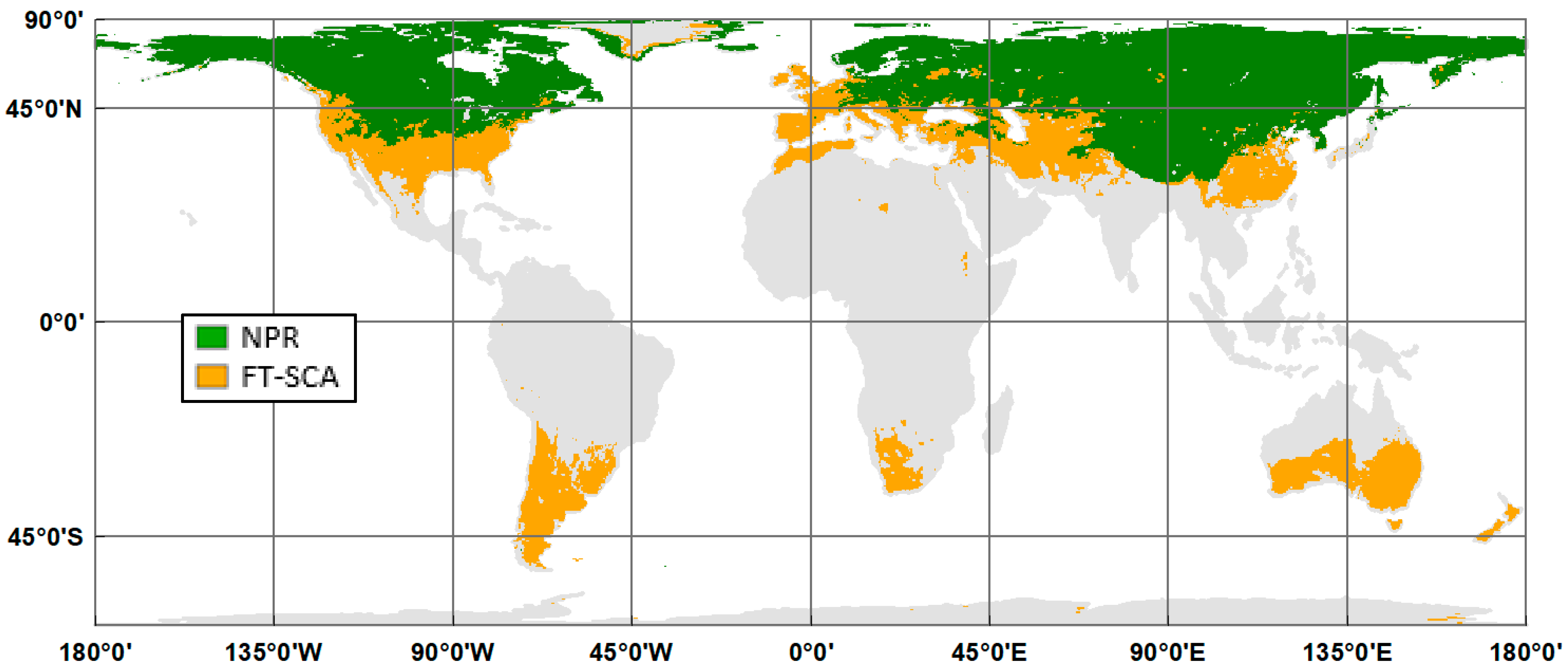
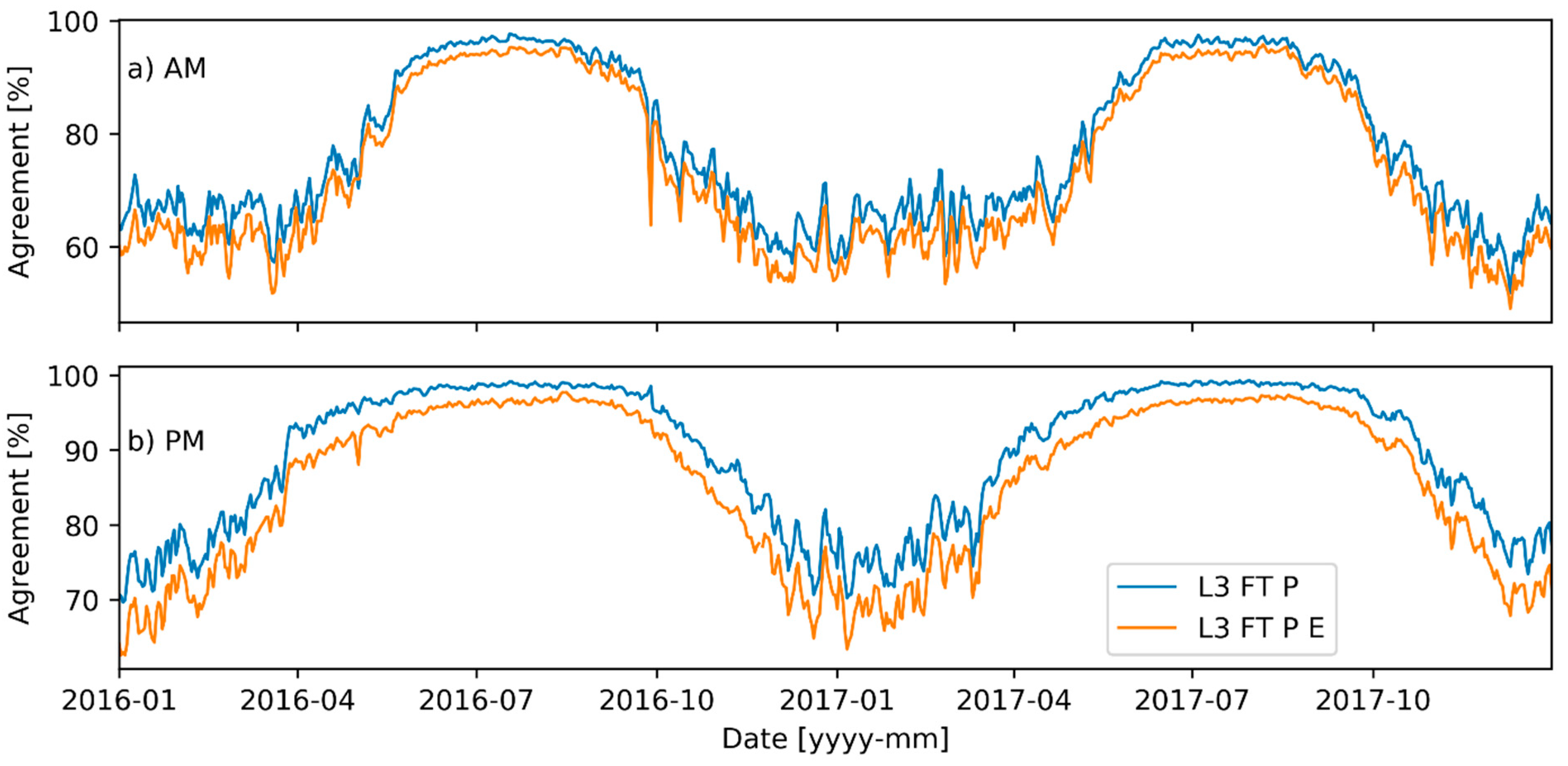
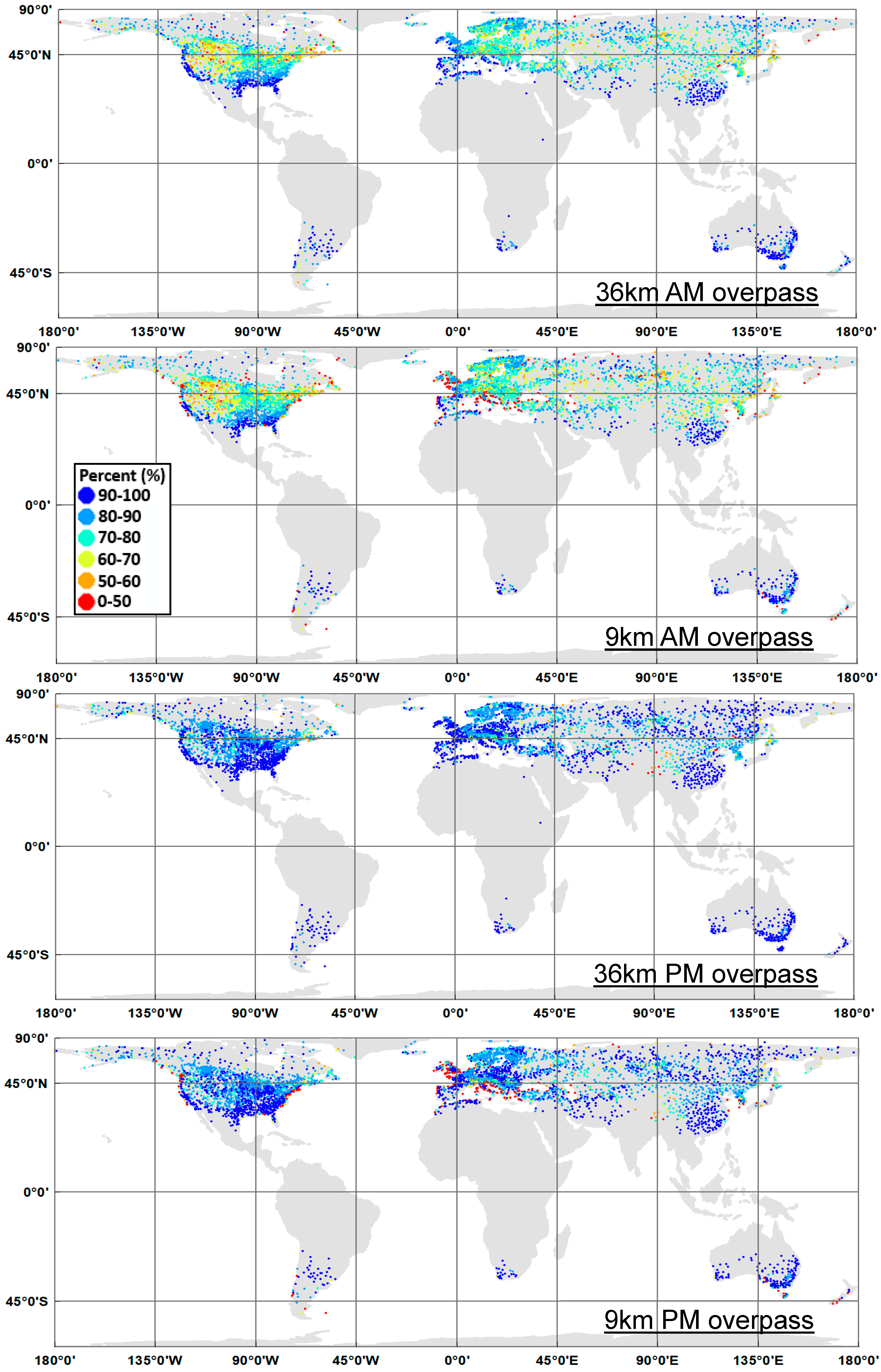
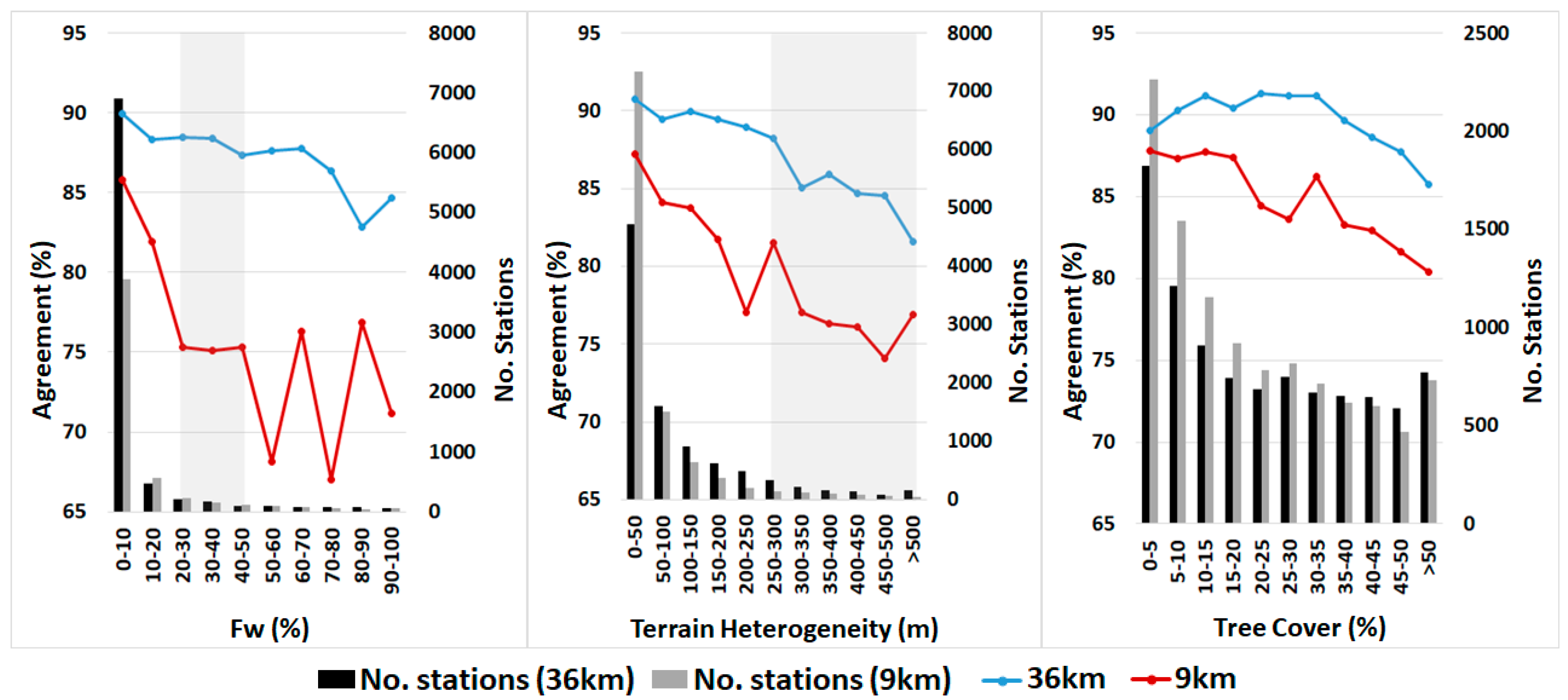
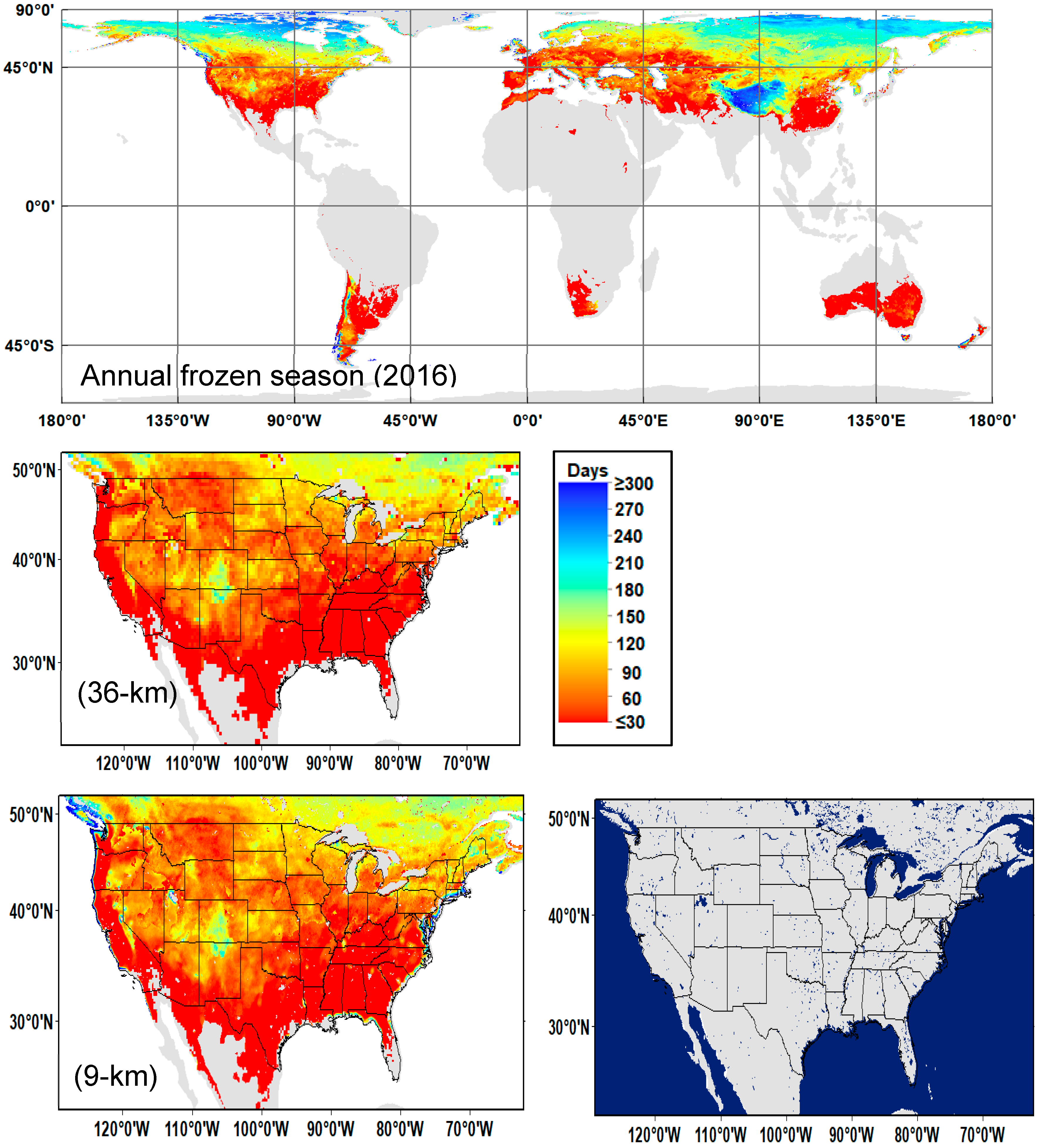

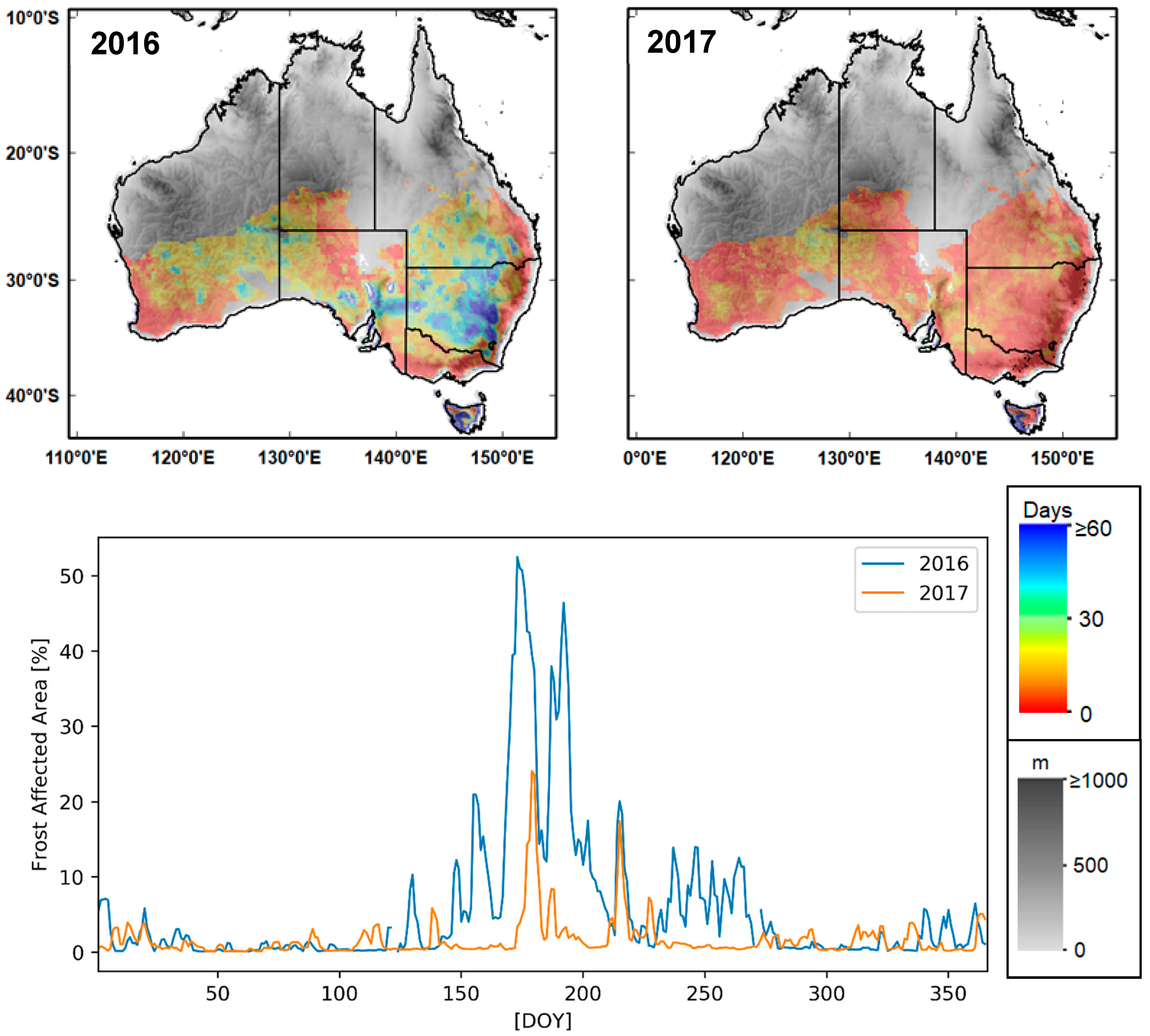
| FT Product | AM Overpass | AM Overpass | PM Overpass | PM Overpass |
|---|---|---|---|---|
| 2016 | 2017 | 2016 | 2017 | |
| 36 km | 78.0 (74.9) | 77.8 (74.7) | 89.6 (87.8) | 89.7 (87.6) |
| 9 km | 74.4 (71.8) | 74.3 (71.7) | 85.6 (84.2) | 85.8 (84.0) |
© 2019 by the authors. Licensee MDPI, Basel, Switzerland. This article is an open access article distributed under the terms and conditions of the Creative Commons Attribution (CC BY) license (http://creativecommons.org/licenses/by/4.0/).
Share and Cite
Kim, Y.; Kimball, J.S.; Xu, X.; Dunbar, R.S.; Colliander, A.; Derksen, C. Global Assessment of the SMAP Freeze/Thaw Data Record and Regional Applications for Detecting Spring Onset and Frost Events. Remote Sens. 2019, 11, 1317. https://doi.org/10.3390/rs11111317
Kim Y, Kimball JS, Xu X, Dunbar RS, Colliander A, Derksen C. Global Assessment of the SMAP Freeze/Thaw Data Record and Regional Applications for Detecting Spring Onset and Frost Events. Remote Sensing. 2019; 11(11):1317. https://doi.org/10.3390/rs11111317
Chicago/Turabian StyleKim, Youngwook, John S. Kimball, Xiaolan Xu, R. Scott Dunbar, Andreas Colliander, and Chris Derksen. 2019. "Global Assessment of the SMAP Freeze/Thaw Data Record and Regional Applications for Detecting Spring Onset and Frost Events" Remote Sensing 11, no. 11: 1317. https://doi.org/10.3390/rs11111317







